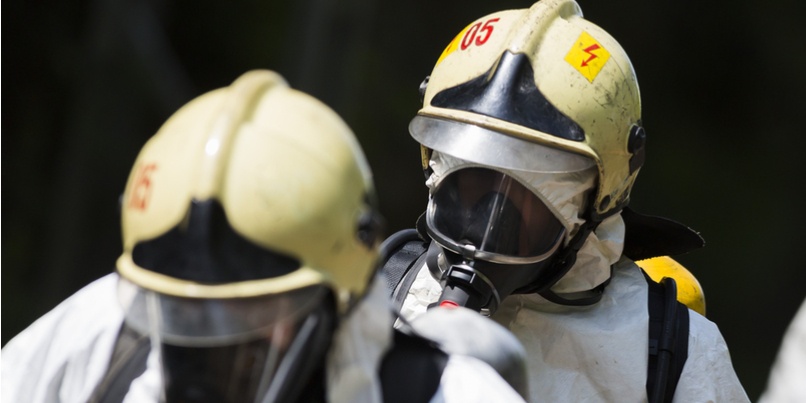
Correctly utilising nuclear training equipment can be a challenge, especially when navigating things like safety considerations, budget, and instrument calibration.
Whether you’re looking to improve your team’s ability to assess alarms and their threat statuses or to effectively prevent the release of a radiological dispersal device (RDD), knowing how to use the equipment safely and correctly can make a significant difference in the ability to identify and prevent a radiological incident before it becomes a public hazard.
In this article, we will take a look at some best practices to consider when using nuclear training equipment, including planning, details on equipment currently in use, and how to solve common issues that arise during training.
→ Download Free Ebook: Wide Area CBRNe and HazMat Training Using PlumeSIM
Planning A Nuclear Training Exercise
Key goals for nuclear training exercises can depend on the type of potential release. First responders and people who work in nuclear industrial fields, for example, need to know how to assess an alarm and determine whether an accidental release has occurred. CBRNe teams, however, usually focus on preventing or responding to planned detonations of RDDs and other nuclear weapons. They may also be called upon to support civilian responders for more serious industrial incidents such as a major nuclear power station release.
Another important consideration is the level of knowledge the trainees already have. First responders are primary screeners, so they are familiar with assessing and adjucating potential threats. CBRNe teams generally have a background in following strategic and tactical interdiction plans, so these can be followed during a nuclear training exercise.
Equally important to planning a scenario with outcome goals and trainees in mind is the need to ensure that the exercise provides a realistic experience with instruments, locations, and materials that are as close to real-world situations as possible. This helps trainees gain a real-life understanding of the significance of the detector readings, helping them to recognise changes in units of measurement and familiarise them with the concept of shielding, survey, contamination avoidance, decontamination procedures, and dose management.
Instructors want to ensure that their teams learn how to properly respond to an array of events, and the best way to achieve this is by exposing them to a variety of realistic, repeatable scenarios at various locations and weather conditions.
Types of Nuclear Training Equipment Currently in Use
As mentioned above, real-world nuclear detectors and devices are key to achieving meaningful learning outcomes, as trainees need to develop the reflexes necessary to react accordingly in potential emergency situations.
Trainees ideally should focus on using standard equipment such as:
-
Personal Radiation Detectors (PRDs)
-
Radiological Isotope Identification Devices (RIIDs
→ Related: An Introduction to Radiation Safety Training
Challenges Associated With Nuclear Training Exercises
Setting up a nuclear training exercise can be an ordeal in itself due to the hazardous nature of the radioactive materials required. Bringing in real nuclear isotopes for training requires navigating various regulatory measures, including hiring a control technician to stay on-site with the isotopes and sourcing a suitable remote location.
This additionally leads to budget-breaking expenses, especially when adding the instrument calibration fees and other associated costs. All of this can limit how you run your scenario, especially when considering the amounts and types of radiological sources which can be used, where they can be deployed and ultimately the quality of the overall student training experience.
One workaround is opting for button sources, which are materials with minimal enough activity that they don’t fall under the above regulatory considerations. But because these materials are so miniscule, they aren’t strong enough to teach a team how to effectively find a source or carry out other higher reading-related procedures.
This leads to instructors opting for other methods, such as index cards. However, they simply don’t achieve the realism or effectiveness of using real devices.
→Download: Wide Area CBRNe and HazMat Training Using PlumeSIM
How to Solve Common Issues with Nuclear Training Equipment
Achieving realistic and cost-effective nuclear training is much more straightforward than many realise.
Real experience training using simulators is a simple solution to all of the problems mentioned above. The right nuclear simulators will have the exact same look, feel, and operation modes as the real devices, without the need for ionising sources.
With simulators, instructors no longer have to navigate strict regulations or expensive equipment calibration. The devices are ready to set up and use when and where the instructor needs them. This opens up the ability for teams to train almost anywhere – from a busy mall to a government building – all while maintaining complete public safety. This allows for not only a quick and safe training scenario, but repeatability. For larger area exercises Argon’s PlumeSIM wide area HazMat and CBRNe training system offers all of this, including powerful after-action review for effective learning outcomes.
Most importantly, nuclear training with simulators maintains the level of realism necessary for effective and meaningful learning. Trainees will more confidently interpret readings on their devices, understand the significance of any changes in the units of measurement, and accurately relay their findings to those higher up the chain of command.
To learn more about the role simulator detectors play in boosting training authenticity, and more specifically the PlumeSIM, download our free ebook: A Guide to CBRNe and HazMat Wide Area Simulation Training Using PlumeSIM.





